Strengthening Process by Electron Beam to Carbon Fiber for Impact Strength Enhancement of Interlayered Thermoplastic-Polypropylene Carbon Fiber Composite
Abstract
1. Introduction
2. Materials and Methods
2.1. Samples
2.2. Condition of EBI
2.3. Charpy Impact Test
2.4. Cumulative Probability
3. Results: Effects of EBI to CF on Impact Value of CFRTPP
4. Discussion
4.1. Statistically Lowest Impact Value auc (as) at Pf = 0
4.2. Predicted Strengthening Mechanism
5. Conclusions
- Experimental results showed EBI dose of 43.2, 129, or 216 kGy improved Charpy impact values, auc at all cumulative probabilities, Pf over untreated.
- The 129 kGy-EBI doses yielded the highest auc; hence, is considered at or near the optimum. The 129 kGy-EBI raised auc to 30.4, 33.7, and 38.8 kJm−2, which were about 103%, 83%, and 65% higher than that of untreated at 15, 18, and 23.5 kJm−2 at low, median, and high Pf of 0.07, 0.50 and 0.93, respectively.
- The 129 kGy EBI dose increased the statistically lowest impact value as at Pf = 0 calculated by 3-dimensional Weibull method about 110% over untreated indicating increased safety and reliability.
- It is assumed improvements in auc result from formation of maximum number of strong covalent bonds CF:C:O:C:PP and CF:C:C:PP at the CF/PP interface, along with cross-linking in the PP near the CF/PP interface.
- Higher EBI dose of 216 kGy lowering the auc is predicted to occur by covalent bond generation accompanied by radiation damage in the form of bond severing at the CF/PP interface; along with cross-linking with severing in the PP near the interface. Therefore, EBI dose must be adjusted carefully when using for practical parts.
Author Contributions
Funding
Institutional Review Board Statement
Informed Consent Statement
Data Availability Statement
Acknowledgments
Conflicts of Interest
References
- Yao, S.S.; Jin, F.L.; Rhee, K.Y.; Hui, D.; Park, S.J. Recent advances in carbon-fiber-reinforced thermoplastic composites: A review. Compos. B Eng. 2018, 142, 241–250. [Google Scholar] [CrossRef]
- Nomura, R.; Kanda, M.; Faudree, M.C.; Jimbo, I.; Nishi, Y. Improving impact value of interlayered glass fiber chopped strand mat reinforced thermoplastic polypropylene externally irradiated by homogeneous low potential electron beam. Mater. Trans. 2016, 57, 1915–1921. [Google Scholar] [CrossRef]
- Nomura, R.; Kanda, M.; Faudree, M.C.; Jimbo, I.; Nishi, Y. Internal activation of thermoplastic polypropylene GFRTP composite by homogeneous low energy electron beam irradiation (HLEBI) of the interlayered glass fiber chopped strand mats (GF-CSM) prior to assembly. Mater. Trans. 2016, 57, 417–422. [Google Scholar] [CrossRef]
- Kitagawa, S.; Kimura, H.; Uchida, H.T.; Faudree, M.C.; Tonegawa, A.; Kaneko, S.; Salvia, M.; Nishi, Y. A new process of thermoplastic polypropylene reinforced by interlayered activated carbon fiber treated by electron beam irradiation under nitrogen gas atmosphere with oxygen prior to assembly and hot-press. Mater. Trans. 2019, 60, 587–592. [Google Scholar] [CrossRef]
- Tiwari, S.; Bijwe, J. Surface treatment of carbon fibers: A review. Procedia Tech. 2014, 14, 505–512. [Google Scholar] [CrossRef]
- Sharma, M.; Gao, S.; Mader, E.; Sharma, H.; Wei, L.-Y.; Bijwe, J. Carbon fiber surfaces and composite interphases. Compos. Sci. Tech. 2014, 102, 35–50. [Google Scholar] [CrossRef]
- Xu, Z.; Chen, L.; Huang, Y.; Li, J.; Wu, X.; Li, X.; Jio, Y. Wettability of carbon fibers modified by acrylic acid and interface properties of carbon fiber/epoxy. Eur. Polym. J. 2008, 44, 494–503. [Google Scholar] [CrossRef]
- Wu, Z.; Pittman, C.U., Jr.; Gardner, S.D. Nitric acid oxidation of carbon fibers and the effects of subsequent treatment in refluxing aqueous NaOH. Carbon 1995, 33, 597–605. [Google Scholar] [CrossRef]
- Cai, G.; Wada, M.; Ohsawa, I.; Kitaoka, S.; Takahashi, J. Interfacial adhesion of recycled carbon fibers to polypropylene resin: Effect of superheated steam on the surface chemical state of carbon fiber. Compos. A 2019, 120, 33–40. [Google Scholar] [CrossRef]
- Tiwari, S.; Sharma, M.; Panier, S.; Mutel, B.; Mitschang, P.; Bijwe, P. Influence of cold remote nitrogen oxygen plasma treatment on carbon fabric and its composites with specialty polymers. J. Mater. Sci. 2011, 46, 964–974. [Google Scholar] [CrossRef]
- Pittman, C.U.; Jiang, W.; He, G.R.; Gardner, S.D. Oxygen plasma and isobutylene plasma treatments of carbon fibers: Determination of surface functionality and effects on composite properties. Carbon 1998, 36, 25–37. [Google Scholar] [CrossRef]
- Sherwood, P.M.A. Surface analysis of carbon and carbon fibers for composites. Electron Spectrosc. Relat. Phenom. 1996, 81, 319–342. [Google Scholar] [CrossRef]
- Montes-Morán, M.A.; Martínez-Alonso, A.; Tascón, J.M.D.; Young, R.J. Effects of plasma oxidation on the surface and interfacial properties of ultra-high modulus carbon fibres. Compos. Part A 2001, 32, 361–371. [Google Scholar] [CrossRef]
- Hung, B.; Li, J.; Fan, Q.; Chen, Z.H. The enhancement of carbon fiber modified with electropolymer coating to the mechanical properties of epoxy resin composites. Compos. Part A 2008, 39, 1133–1140. [Google Scholar] [CrossRef]
- Bao, D.; Cheng, X. Evaluation of tribological performance of PTFE composite filled with rare earths treated carbon fibers under water-lubricated condition. J. Rare Earths 2006, 24, 564–568. [Google Scholar] [CrossRef]
- Zhang, X.R.; Zhao, P.; Pei, X.Q.; Wang, Q.H.; Jia, Q. Flexural strength and tribological properties of rare earth treated short carbon fiber/polyimide composites. Express Polym. Lett. 2007, 1, 667–672. [Google Scholar] [CrossRef]
- Sudhin, A.U.; Remanan, M.; Ajeesh, G.; Jayanarayanan, K. Comparison of properties of carbon fiber reinforced thermoplastic and thermosetting composites for aerospace applications. Mater. Today. Proc. 2020, 24, 453–462. [Google Scholar] [CrossRef]
- Ashfaq, A.; Clochard, M.C.; Coqueret, X.; Dispenza, C.; Driscoll, M.S.; Ulański, P.; Al-Sheikhly, M. Polymerization reactions and modifcations of polymers by ionizing radiation. Polymers 2020, 12, 2877. [Google Scholar] [CrossRef]
- Chmielewski, A.G.; Haji-Saeid, M. Radiation technologies: Past, present and future. Radiat. Phys. Chem. 2004, 71, 17–21. [Google Scholar] [CrossRef]
- Clough, R.L. High-energy radiation and polymers: A review of commercial processes and emerging applications. Nucl. Instrum. Methods Phys. Res. Sect. B 2001, 185, 8–33. [Google Scholar] [CrossRef]
- Xu, Z.; Huang, Y.; Zhang, C.; Liu, L.; Zhang, Y.; Wang, L. Effect of γ-ray irradiation grafting on the carbon fibers and interfacial adhesion of epoxy composites. Compos. Sci. Tech. 2007, 67, 3261–3270. [Google Scholar] [CrossRef]
- Wan, Y.Z.; Wang, Y.L.; Huang, Y.; Luo, H.L.; Chen, G.C.; Yuan, C.D. Effect of surface treatment of carbon fibers with gamma-ray radiation on mechanical performance of their composites. J. Mater. Sci. 2005, 40, 3355–3359. [Google Scholar] [CrossRef]
- Li, J.; Huang, Y.; Xu, Z.; Wang, Z. High-energy radiation technique treat on the surface of carbon fiber. Mater. Chem. Phys. 2005, 94, 315–321. [Google Scholar] [CrossRef]
- Yoo, S.H. Short review of utilization of electron-beam irradiation for preparing polyacrylonitrile-based carbon fibers and improving properties of carbon-fiber-reinforced thermoplastics. Carbon Lett. 2022, 32, 413–429. [Google Scholar] [CrossRef]
- Kim, B.H.; Lee, D.H.; Yang, K.S.; Lee, B.C.; Kim, Y.A.; Endo, M. Electron beam irradiation-enhanced wettability of carbon fbers. ACS Appl. Mater. Interfaces 2020, 3, 119–123. [Google Scholar] [CrossRef] [PubMed]
- Zeng, L.; Liu, X.; Chen, X.; Soutis, C. π-π interaction between carbon fibre and epoxy resin for interface improvement in composites. Compos. Part B 2021, 220, 108983. [Google Scholar] [CrossRef]
- Mizutani, A.; Nishi, Y. Improved strength in carbon fiber reinforced plastics due after electron beam irradiation. Mater. Trans. 2003, 44, 1857–1860. [Google Scholar] [CrossRef]
- Nishi, Y.; Inoue, K.; Salvia, M. Improvement of Charpy impact of carbon fiber reinforced polymer by low energy sheet electron beam irradiation. Mater. Trans. 2006, 47, 2846–2851. [Google Scholar] [CrossRef]
- Zhao, X.; Duan, Y.; Li, D.; Wang, B.; Zhang, X. Investigation of curing characteristics of carbon fiber/epoxy composites cured with low-energy electron beam. Polym. Compos. 2015, 36, 1731–1737. [Google Scholar] [CrossRef]
- Nishi, Y.; Takei, H.; Iwata, K.; Salvia, M.; Vautrin, A. Effects of electron beam irradiation on impact value of carbon fiber reinforced thermoplastic polyetheretherketone. Mater. Trans. 2009, 50, 2826–2832. [Google Scholar] [CrossRef]
- Faudree, M.C.; Uchida, H.T.; Kimura, H.; Kaneko, S.; Salvia, M.; Nishi, Y. Advances in titanium/polymer hybrid joints by carbon fiber plug insert: Current status and review. Materials 2022, 15, 3220. [Google Scholar] [CrossRef] [PubMed]
- Vautard, F.; Fioux, P.; Vidal, L.; Sifer, F.; Roucoules, V.; Schultz, J.; Nardin, M.; Defoort, B. Use of plasma polymerization to improve adhesion strength in carbon fiber composites cured by electron beam. ACS Appl. Mater. Interfaces 2014, 6, 1662–1674. [Google Scholar] [CrossRef]
- Zhenjuan, Z.; Yuansheng, W.; Qinyi, D.; Siliang, W.; Te, H. Surface modifcation of carbon fber via electron-beam irradiation grafting. Surf. Interface Anal. 2013, 45, 913–918. [Google Scholar] [CrossRef]
- Park, S.K.; Jung, S.; Lee, D.Y.; Ghim, H.; Yoo, S.H. Effects of electron-beam irradiation and radiation cross-linker on tensile properties and thermal stability of polypropylene-based carbon fiber reinforced thermoplastic. Polymer Degrad. Stab. 2020, 181, 109301. [Google Scholar] [CrossRef]
- Nishi, Y.; Kitagawa, S.; Faudree, M.C.; Uchida, H.T.; Kanda, M.; Takase, S.; Kaneko, S.; Endo, T.; Tonegawa, A.; Salvia, M.; et al. Improvements of strength of layered polypropylene reinforced by carbon fiber by its sizing film and electron beam under protective nitrogen gas atmosphere. In Carbon Related Materials; Kaneko, S., Aono, M., Pruna, A., Can, M., Mele, P., Ertugrul, M., Endo, T., Eds.; Springer: Singapore, Singapore, 2021; pp. 279–302. [Google Scholar]
- Gordon, A.; Ford, R. The Chemist’s Companion: A Handbook of Practical Data, Techniques, and References; Wiley Interscience Publication: New York, NY, USA, 1972; pp. 112–113. ISBN 978-0-471-31590-2. [Google Scholar]
- James, A.; Lord, M. Macmillan’s Chemical and Physical Data; The Macmillan Press, Ltd.: London, UK; Basingstoke, UK, 1992; pp. 484–485. ISBN 0-333-51167-0. [Google Scholar]
- Christenhusz, R.; Reimer, L. Schichtdickenabhangigkeit der warmerzeugungdurch elektronenbestrahlung im energiebereich zwischen 9 und 100 keV (Layer thickness dependency of heat generation by electron irradiation in the energy range between 9 and 100 keV). Z. Angew. Phys. 1967, 23, 396–404. [Google Scholar]
- Nishida, T.; Yasuda, E. Evaluation of Dynamic Properties of Ceramics (In Japanese: Ceramics no Rikigaku Tokusei Hyouka); Nikkan Kogyou Shimbun Sha: Tokyo, Japan, 1986; pp. 50–51. [Google Scholar]
- Weibull, W. A Statistical Theory of the Strength of Materials; Ingeniörs Vetenskaps Akademien; Nr. 153; (Generalstabens Litografiska Anstalts Förlag); Engineer Science Academy, Lithographic Institution Publisher: Stockholm, Sweden, 1939; pp. 16–22. [Google Scholar]
- Jung, S.; Park, S.K.; Ghim, H.D.; Lee, D.Y.; Yoo, S.H. Synergetic effect of cross-linking and interfacial interaction in carbon fiber reinforced thermoplastic to enhance its tensile strength by electron-beam irradiation. Carbon Lett. 2020, 30, 165–175. [Google Scholar] [CrossRef]
- Nishi, Y.; Uchida, N.; Kimura, A.; Mizutani, A.; Oguri, K.; Tonegawa, A. Effects of EB irradiation on spring constant of C/C composite coil. J. Mater. Sci. 2003, 38, 2215–2218. [Google Scholar] [CrossRef]
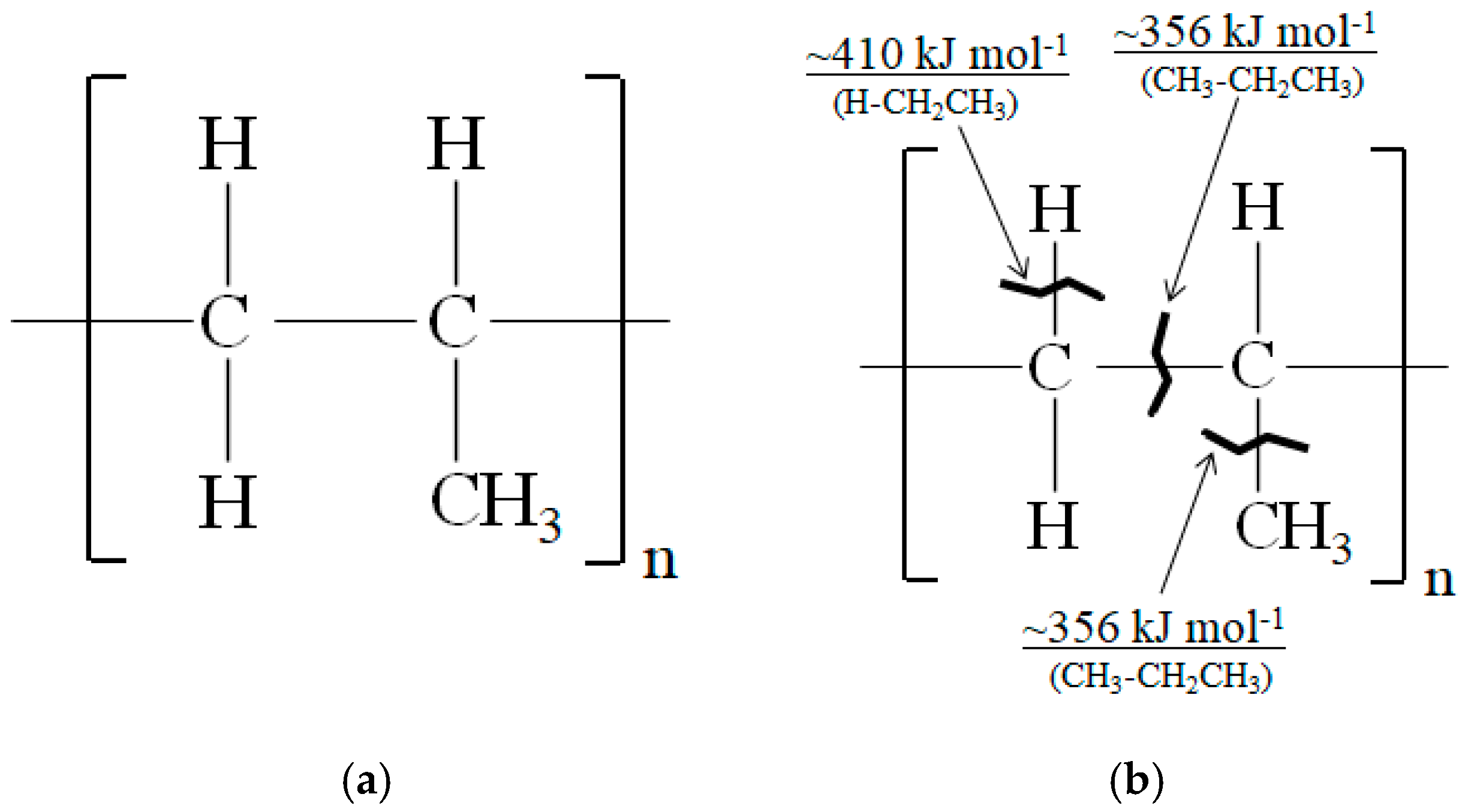


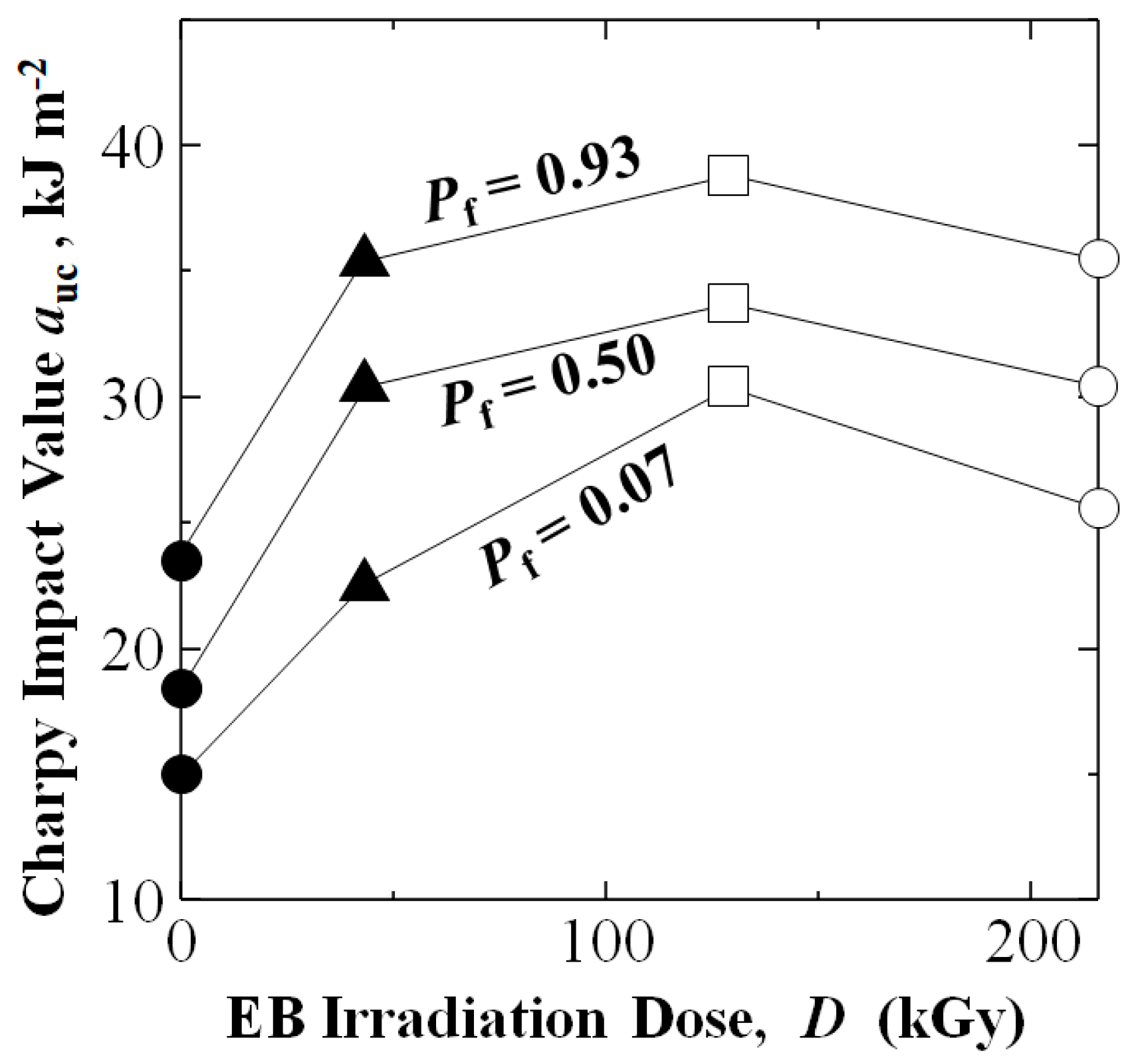
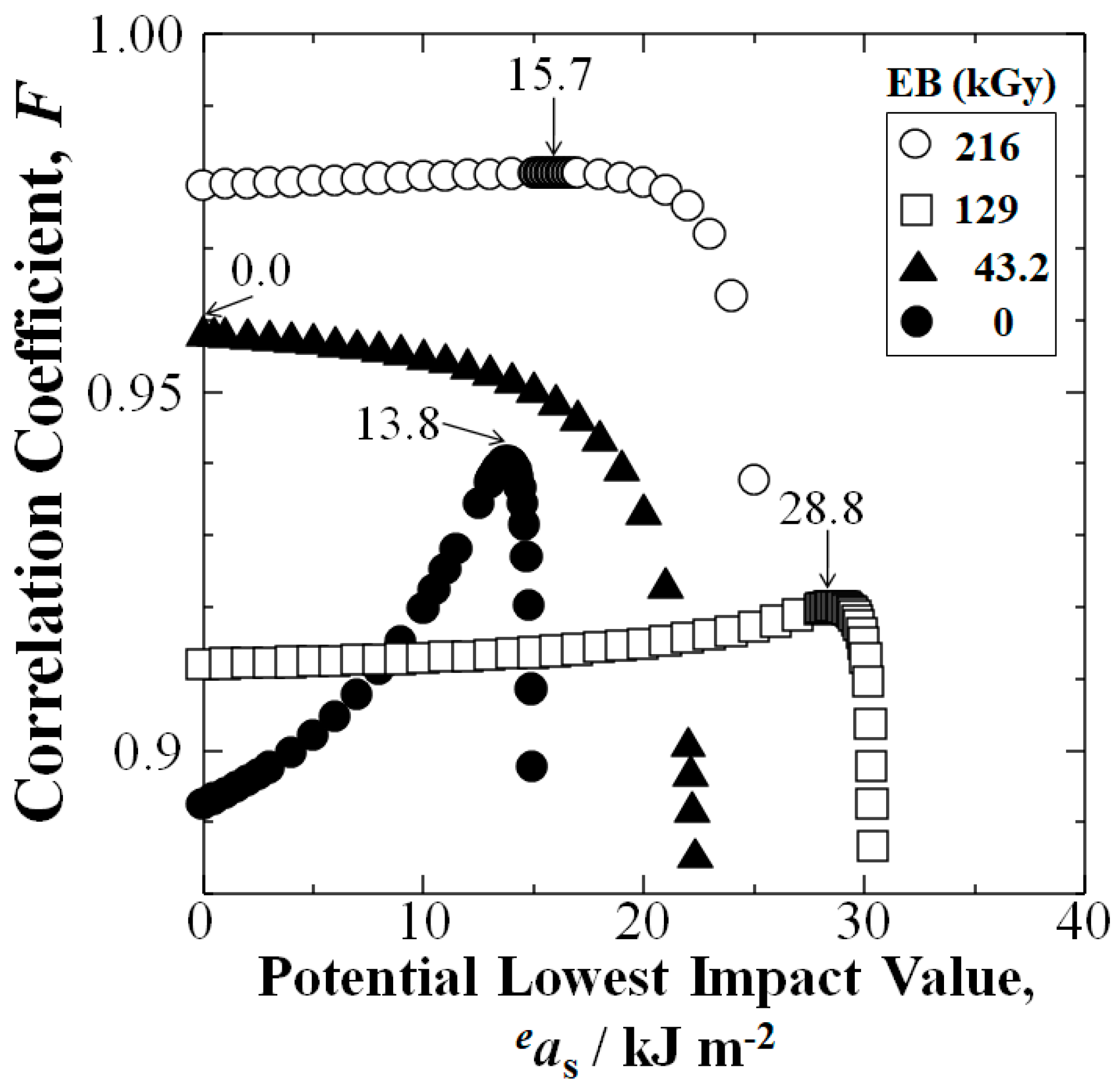

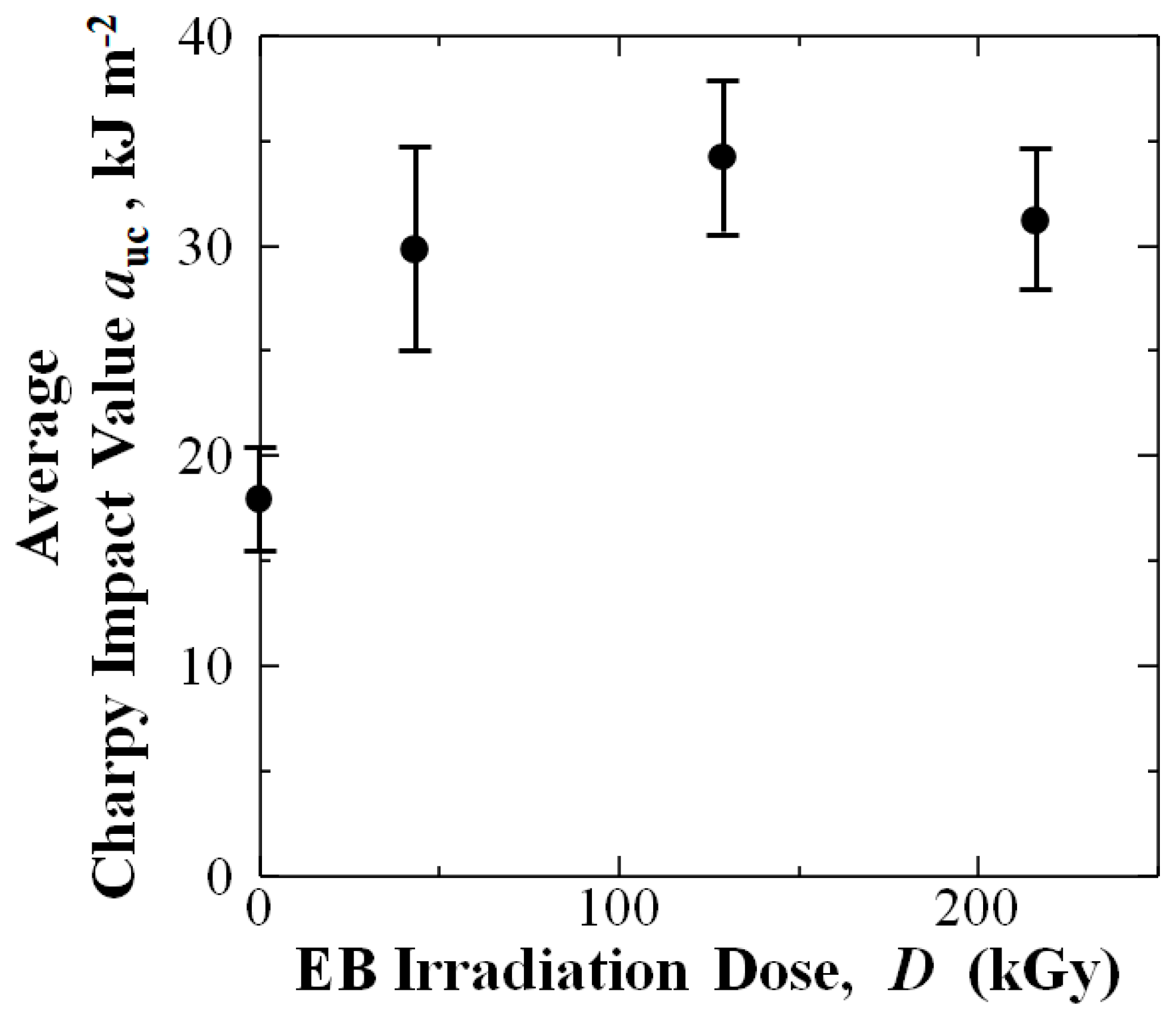
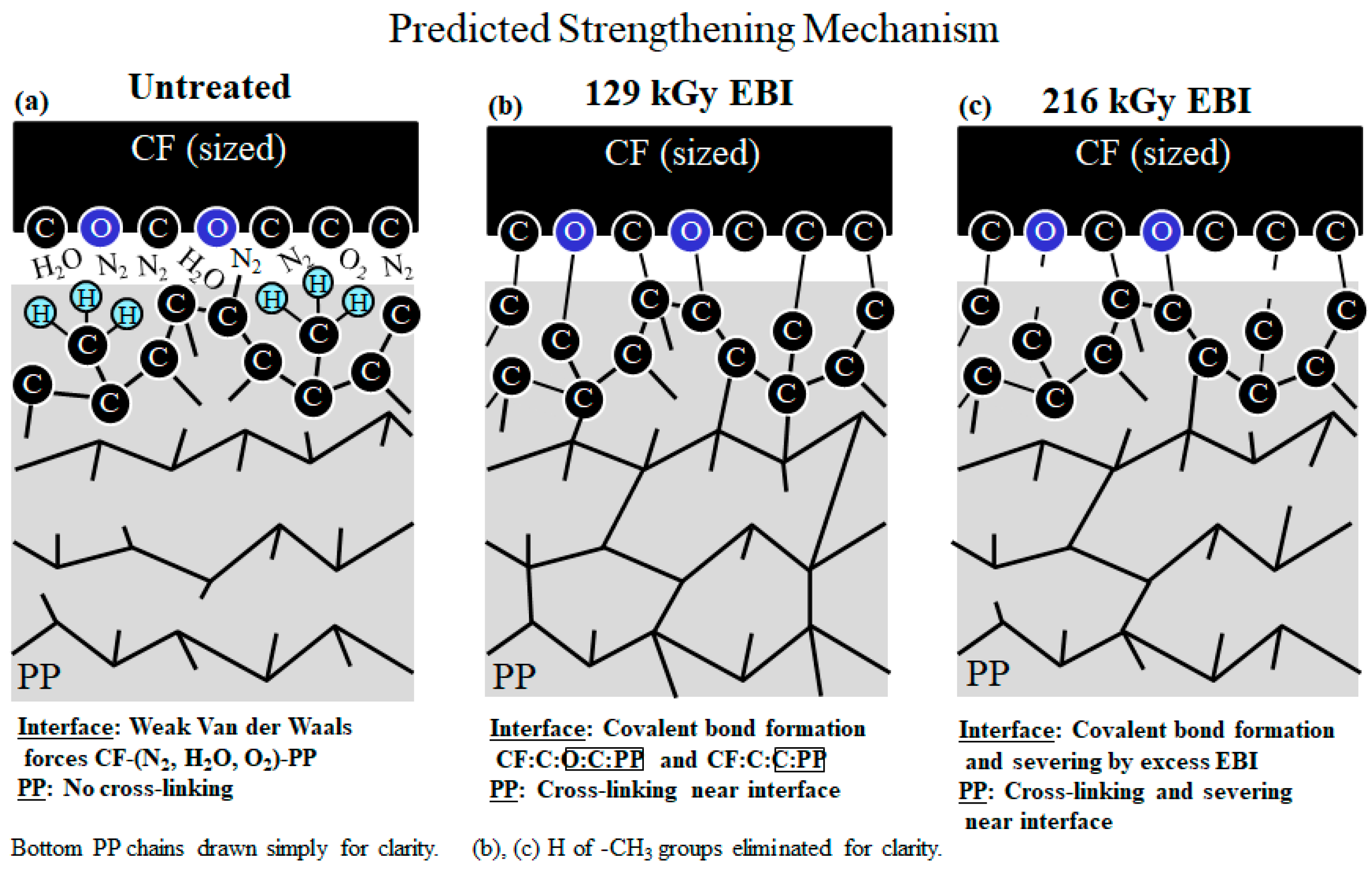
| Parameter | Setting | Parameter | Setting |
|---|---|---|---|
| Linear electron gun | Ti filament | EBI dose/Sweep | 43.2 kGy |
| Acceleration potential | 170 kV | Time/Sweep | 23 s |
| Current density | 0.089 Am−2 | Conveyor speed | 10 m min−1 |
| Distance Sample and Ti window | 25 mm | Time between sweeps | 30 s |
| Sample atmosphere | N2 (<300 ppm O2) | Tmax of sample | 323 K |
| N2 flow rate and P | 1.5 Ls−1, 0.1 MPa |
| Untreated | 43.2 kGy | 129 kGy | 216 kGy | |
|---|---|---|---|---|
| avg. auc (std. dev.) | 17.9 (2.5) | 29.8 (4.9) | 34.2 (3.6) | 31.2 (3.4) |
| median auc at Pf = 0.50 | 18.4 | 30.4 | 33.7 | 30.4 |
Publisher’s Note: MDPI stays neutral with regard to jurisdictional claims in published maps and institutional affiliations. |
© 2022 by the authors. Licensee MDPI, Basel, Switzerland. This article is an open access article distributed under the terms and conditions of the Creative Commons Attribution (CC BY) license (https://creativecommons.org/licenses/by/4.0/).
Share and Cite
Kimura, H.; Takeda, K.; Uchida, H.T.; Faudree, M.C.; Sagawa, K.; Kaneko, S.; Salvia, M.; Nishi, Y. Strengthening Process by Electron Beam to Carbon Fiber for Impact Strength Enhancement of Interlayered Thermoplastic-Polypropylene Carbon Fiber Composite. Materials 2022, 15, 7620. https://doi.org/10.3390/ma15217620
Kimura H, Takeda K, Uchida HT, Faudree MC, Sagawa K, Kaneko S, Salvia M, Nishi Y. Strengthening Process by Electron Beam to Carbon Fiber for Impact Strength Enhancement of Interlayered Thermoplastic-Polypropylene Carbon Fiber Composite. Materials. 2022; 15(21):7620. https://doi.org/10.3390/ma15217620
Chicago/Turabian StyleKimura, Hideki, Keisuke Takeda, Helmut Takahiro Uchida, Michael C. Faudree, Kohei Sagawa, Satoru Kaneko, Michelle Salvia, and Yoshitake Nishi. 2022. "Strengthening Process by Electron Beam to Carbon Fiber for Impact Strength Enhancement of Interlayered Thermoplastic-Polypropylene Carbon Fiber Composite" Materials 15, no. 21: 7620. https://doi.org/10.3390/ma15217620
APA StyleKimura, H., Takeda, K., Uchida, H. T., Faudree, M. C., Sagawa, K., Kaneko, S., Salvia, M., & Nishi, Y. (2022). Strengthening Process by Electron Beam to Carbon Fiber for Impact Strength Enhancement of Interlayered Thermoplastic-Polypropylene Carbon Fiber Composite. Materials, 15(21), 7620. https://doi.org/10.3390/ma15217620







